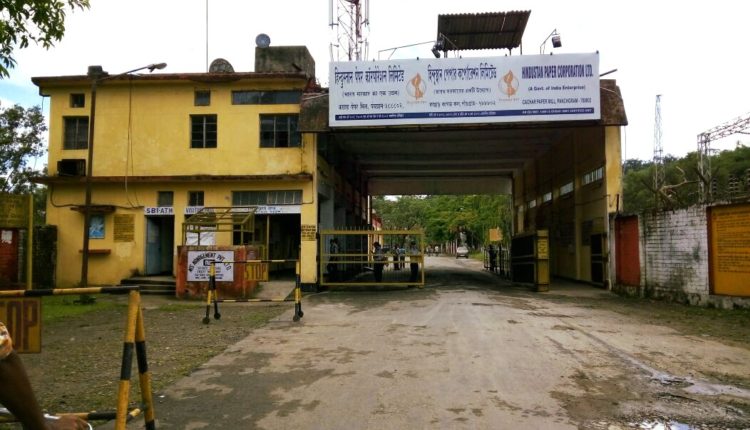Cachar Paper Mill is a significant industrial hub in Assam, India. It plays a crucial role in the region’s economy and employment.
Nestled in the lush greenery of Assam, Cachar Paper Mill stands as a testament to industrial progress. With its establishment, the mill has not only provided employment to thousands but also contributed substantially to the local economy. The mill specializes in producing a variety of paper products, serving both national and international markets.
Despite facing challenges over the years, it remains a cornerstone of the paper industry in Northeast India. Understanding its operations, history, and impact can offer valuable insights into the industrial landscape of the region. Join us as we explore the fascinating journey and significance of Cachar Paper Mill.
Founding Of Cachar Paper Mill
The Cachar Paper Mill has a rich history. It stands as a testament to industrial growth. This mill has played a vital role in the local economy. Let’s explore its journey from inception to becoming a key industry player.
Early Beginnings
The idea for Cachar Paper Mill took root in the early 1970s. India needed more paper production facilities. Assam’s rich bamboo forests offered the perfect location. The government saw potential in this untapped resource. They decided to build a paper mill in this region.
Construction began in 1975. The project aimed to create jobs and boost local industry. It also intended to reduce India’s reliance on imported paper. The mill started operations in 1988. This marked the beginning of a new era for the Cachar region.
Key Figures And Visionaries
Several key figures played a role in the mill’s founding. One notable name is Dr. K. P. Goenka. He envisioned a self-reliant paper industry in India. His leadership and vision were instrumental. Dr. Goenka’s efforts ensured the project’s success.
Another important figure is Mr. S. P. Srivastava. He was the first General Manager of the mill. His management skills helped navigate early challenges. He laid the foundation for its operational success.
These visionaries shared a common goal. They aimed to make India self-sufficient in paper production. Their combined efforts led to the creation of the Cachar Paper Mill. This mill has since become a cornerstone of the local economy.

Credit: barakbulletin.com
Economic Contributions
Cachar Paper Mill has been a significant pillar of the local economy. Its economic contributions have impacted various aspects of the surrounding communities. Let’s dive into the specifics of its role in job creation and the local economy boost.
Job Creation
Cachar Paper Mill has created thousands of jobs for local residents. It provides employment opportunities for both skilled and unskilled workers. Many families depend on these jobs for their daily livelihood. The mill also offers training programs to improve workers’ skills. This ensures a steady workforce and fosters community growth. By hiring locally, the mill reduces unemployment rates in the area.
Local Economy Boost
The mill’s operations significantly boost the local economy. Suppliers and small businesses benefit from the mill’s needs for goods and services. Local farmers sell raw materials like bamboo to the mill. This creates a reliable market for their produce. The presence of the mill also attracts other businesses to the region. Restaurants, shops, and service providers thrive due to the mill’s workforce. This economic activity leads to increased tax revenues for local governments. These funds support public services like schools and healthcare.
Technological Advancements
Cachar Paper Mill has embraced technological advancements to enhance production efficiency. Modern machinery and automation ensure high-quality paper output with reduced manual labor. This progress supports sustainable practices while meeting industry demands.
### Technological Advancements at Cachar Paper Mill Cachar Paper Mill has always been at the forefront of the paper manufacturing industry. It has managed to stay relevant and efficient by adopting cutting-edge technologies. These advancements not only improve production but also align with sustainable practices. Let’s dive into some of the innovative practices and sustainable methods that make Cachar Paper Mill a leader in the field.Innovative Practices
Cachar Paper Mill has embraced various innovative practices to enhance its production capabilities. One key innovation is the integration of automation in the production line. Automated systems handle everything from raw material processing to final product packaging. This minimizes human error and significantly boosts productivity. Another innovative practice is the use of advanced sensors and IoT (Internet of Things) technologies. These sensors monitor the equipment’s performance and predict maintenance needs before a breakdown occurs. Imagine avoiding unexpected downtimes and ensuring a smoother workflow! The mill has also invested in high-speed paper machines. These machines can produce paper at an astonishing rate without compromising on quality. This means more paper in less time, which is a win-win for both the company and its customers.Sustainable Methods
Sustainability is at the heart of Cachar Paper Mill’s technological advancements. The mill has adopted various eco-friendly methods to reduce its environmental impact. One such method is the recycling of waste paper. By recycling, the mill significantly reduces the need for virgin pulp, thereby conserving trees. You might be surprised to know that recycled paper can be just as high-quality as paper made from new pulp. The mill also uses water treatment technologies to purify and reuse water. This reduces water consumption and helps in maintaining local water bodies. If you’ve ever worried about industrial waste polluting rivers, this should come as a relief. Energy efficiency is another area where the mill excels. It has installed energy-efficient machinery and uses renewable energy sources like solar panels. This not only cuts down on electricity bills but also reduces the carbon footprint. Have you ever considered the impact of your daily paper use on the environment? By choosing products from companies like Cachar Paper Mill, you can make a positive difference. ### Conclusion Technological advancements at Cachar Paper Mill are not just about staying ahead in the industry. They are about creating a sustainable future. Through innovative practices and eco-friendly methods, the mill sets an example for others to follow. So, the next time you use paper, think about where it comes from and the technology behind it. What technological advancements do you think will shape the future of the paper industry? Share your thoughts in the comments below!
Credit: m.facebook.com
Environmental Impact
When it comes to industrial activities, the environmental impact is always a pressing concern. Cachar Paper Mill, nestled in the lush greenery of Assam, India, is no exception. Understanding the environmental impact of this mill is essential for making informed decisions about its operations and future. Let’s delve into some key aspects.
Eco-friendly Initiatives
Cachar Paper Mill has implemented several eco-friendly initiatives to minimize its carbon footprint and preserve the surrounding environment. One of the most notable efforts is the adoption of renewable energy sources. The mill has invested in solar panels, significantly reducing its reliance on non-renewable energy.
Additionally, the mill has adopted a zero-liquid discharge system. This means that no wastewater is released into the local water bodies. Instead, the water is treated and reused within the mill. This initiative not only protects the local ecosystem but also conserves water—an invaluable resource.
Another significant step is the introduction of eco-friendly raw materials. By using bamboo and agricultural residues instead of wood, the mill helps in reducing deforestation. This sustainable approach ensures that paper production does not come at the cost of our forests.
Challenges And Solutions
While these eco-friendly initiatives are commendable, Cachar Paper Mill faces several challenges. One major issue is the management of solid waste. The production process generates a significant amount of waste, which, if not managed properly, can lead to land pollution.
To tackle this, the mill has set up a comprehensive waste management system. This includes recycling paper waste and converting it into useful by-products like packaging materials. This not only reduces waste but also creates additional revenue streams for the mill.
Air pollution is another concern, primarily due to the emissions from the mill’s boilers. To address this, the mill has installed advanced air filters and scrubbers. These devices help in capturing harmful particles and gases, ensuring that the air released is much cleaner.
Moreover, engaging local communities is crucial for the mill’s environmental initiatives. By conducting awareness programs, the mill educates the local population about the importance of environmental conservation and how they can contribute. This collaborative approach fosters a sense of responsibility and community participation.
Have you ever thought about the environmental impact of the products you use daily? Every small step counts, and understanding these impacts can lead to more sustainable choices.
The journey towards sustainability is ongoing and requires constant effort. But with dedicated initiatives and a proactive approach, Cachar Paper Mill is making significant strides in minimizing its environmental footprint. What eco-friendly practices do you think industries should adopt to protect our planet?
Community Engagement
The Cachar Paper Mill has long been a cornerstone in the region. It stands out not only for its industrial achievements but also for its community engagement. The mill actively participates in various social programs and educational initiatives. These efforts show the mill’s commitment to improving the lives of those around it.
Social Programs
The Cachar Paper Mill organizes health camps for the local community. These camps offer free medical check-ups and essential medicines. They also conduct blood donation drives. Many employees and local residents participate. This strengthens the bond between the mill and the community.
The mill also supports local sports events. It sponsors football and cricket tournaments. These events bring joy and unity to the community. They also promote a healthy lifestyle among the youth.
Educational Initiatives
Education is a priority for the Cachar Paper Mill. The mill runs scholarship programs for students. These scholarships help deserving students continue their studies. Many students have benefited from this support.
The mill also collaborates with local schools. They provide essential educational materials. Books, notebooks, and stationery are distributed regularly. This ensures that students have the resources they need to succeed.
The mill has also set up computer labs in schools. These labs offer students access to technology. They learn important computer skills. This prepares them for future opportunities in a digital world.
Challenges Faced
Running a paper mill in today’s dynamic economy is no small feat. The Cachar Paper Mill has encountered numerous hurdles over the years. Understanding these challenges can shed light on the complexities of maintaining such a vital industry. In this section, we’ll delve into two major areas: Economic Downturns and Operational Hurdles.
Economic Downturns
Economic fluctuations have a profound impact on industries worldwide, and the Cachar Paper Mill is no exception. When the economy takes a hit, businesses often tighten their belts. This usually leads to a reduction in demand for paper products, affecting production schedules and profitability.
During my visit to the mill last year, I noticed a sharp decline in worker morale. Many employees voiced their concerns over job security as the mill struggled to maintain a steady workflow. It’s a stark reminder of how economic health directly influences both the business and its workers.
Have you ever wondered how businesses cope during economic slowdowns? The Cachar Paper Mill’s strategy includes diversifying its product range and exploring new markets. This approach helps mitigate some of the financial strain but isn’t a foolproof solution. It’s a constant battle to stay afloat in turbulent economic waters.
Operational Hurdles
Operational challenges are another significant area where the Cachar Paper Mill faces difficulties. One of the most pressing issues is the aging machinery. With limited funds for upgrades, the mill often experiences breakdowns, leading to production delays.
Imagine working with outdated equipment that frequently malfunctions. It’s frustrating and hampers productivity. During a brief interaction with the technical team, they revealed that constant repairs and maintenance take a toll on both time and resources.
Moreover, the mill grapples with supply chain disruptions. Raw material shortages and logistical issues further complicate the smooth running of operations. These problems are exacerbated by regional instability and regulatory challenges.
So, what can be done to overcome these operational hurdles? Investing in modern machinery and building robust supplier networks are critical steps. However, these measures require significant investment and strategic planning, areas where many mills, including Cachar, often struggle.
Addressing these challenges head-on is essential for the survival and growth of the Cachar Paper Mill. As you ponder these issues, think about how industries in your area deal with similar challenges. What strategies do they employ to stay competitive and resilient in the face of adversity?
Future Prospects
The future of Cachar Paper Mill looks bright. The company has ambitious plans to grow. These plans promise exciting changes for the mill and its employees.
Expansion Plans
Cachar Paper Mill aims to expand its production. The goal is to increase output by 50%. This will involve upgrading machinery. New technology will improve efficiency and quality. The expansion will create more jobs. The local community will benefit from this growth. The mill will also explore new markets. This will help in reaching a wider audience.
Vision For Growth
The mill’s vision includes becoming a leader in the paper industry. Sustainability is a key focus. The mill plans to use eco-friendly methods. This will reduce environmental impact. Innovation will drive this vision. The mill seeks to introduce new paper products. These will meet the demands of modern consumers. Training programs will help employees adapt to changes. This ensures everyone is ready for the future. The vision is clear: growth, sustainability, and innovation.

Credit: www.eastmojo.com
Frequently Asked Questions
What’s The Biggest Paper Mill In The United States?
The biggest paper mill in the United States is the International Paper facility in Selma, Alabama. It produces a large volume of paper products annually.
Where Is India’s First Paper Mill?
India’s first paper mill is located in Serampore, West Bengal. Established in 1812, it is known as the Serampore Paper Mill.
Which Place Of Assam Is Famous For Paper Mills?
Jagiroad in Assam is famous for its paper mills. It is home to the Nagaon Paper Mill, a significant producer.
Who Is The Owner Of Bilt Paper Mill?
The owner of Bilt paper mill is Avantha Group. This Indian business conglomerate manages the paper mill operations.
Conclusion
The Cachar Paper Mill holds great historical and economic importance. Its potential for revival offers hope to the local community. Efforts should focus on sustainable practices and modern technology. This will ensure long-term success. Supporting the mill can boost the region’s economy.
It can also create job opportunities. Every step counts in preserving this vital industry. The future of Cachar Paper Mill depends on collective efforts. Let’s contribute to its growth and sustainability. A thriving mill benefits everyone.
{ “@context”: “https://schema.org”, “@type”: “FAQPage”, “mainEntity”: [ { “@type”: “Question”, “name”: “What’s the biggest paper mill in the United States?”, “acceptedAnswer”: { “@type”: “Answer”, “text”: “The biggest paper mill in the United States is the International Paper facility in Selma, Alabama. It produces a large volume of paper products annually.” } } , { “@type”: “Question”, “name”: “Where is India’s first paper mill?”, “acceptedAnswer”: { “@type”: “Answer”, “text”: “India’s first paper mill is located in Serampore, West Bengal. Established in 1812, it is known as the Serampore Paper Mill.” } } , { “@type”: “Question”, “name”: “Which place of Assam is famous for paper mills?”, “acceptedAnswer”: { “@type”: “Answer”, “text”: “Jagiroad in Assam is famous for its paper mills. It is home to the Nagaon Paper Mill, a significant producer.” } } , { “@type”: “Question”, “name”: “Who is the owner of Bilt paper mill?”, “acceptedAnswer”: { “@type”: “Answer”, “text”: “The owner of Bilt paper mill is Avantha Group. This Indian business conglomerate manages the paper mill operations.” } } ] }





